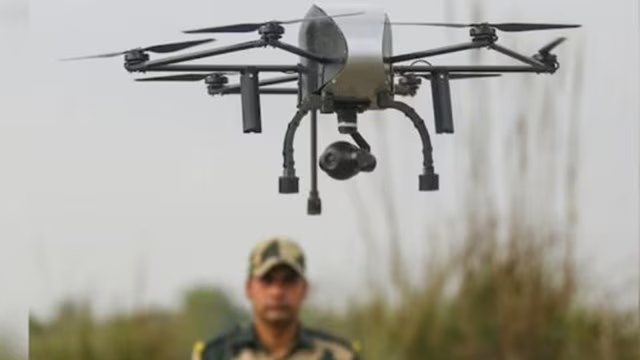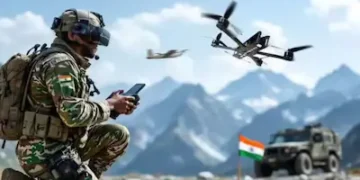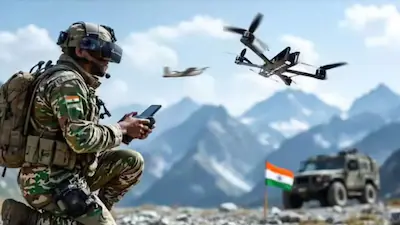Following Operation Sindoor, the Indian Army plans a major overhaul by deploying drones at the battalion level to enhance surveillance and combat readiness.

Army Revamp After Operation Sindoor: Drones to Join Battlefield Asset
The transformation will include the formation of agile light commando battalions, the creation of integrated combat brigades, and the development of specialised artillery regiments and batteries designed to meet the demands of future warfare, according to sources.
These strategic reforms—under discussion for several months—have accelerated in the aftermath of Operation Sindoor, which followed the Pahalgam terror attack in May. Sources indicate that several of the proposed changes are informed by key operational lessons learned during that mission.
One of the key initiatives involves integrating UAVs and counter-UAV systems directly into infantry battalions, as well as armoured and artillery regiments. Although drones are already in use, they are typically treated as secondary tools, with soldiers temporarily reassigned from their main duties to operate them. This often disrupts core operational roles and reduces overall effectiveness.
The new plan aims to establish a specialized team within every unit, specifically responsible for drone operations. According to sources, each branch of the armed forces has been instructed to design an internal structure that designates and trains select personnel to focus exclusively on drone handling and deployment.
This will involve reassigning around 70 personnel from different sections and adjusting the roles of several others. A standard infantry unit consists of 36 combat sections spread across four companies, along with support platoons responsible for various tasks and weapons systems.
In addition to its modernization efforts, the Army is in the process of raising 30 specialized light commando battalions named ‘Bhairav’. Each battalion will consist of approximately 250 personnel, specifically trained for high-impact, mission-oriented operations. These units will be strategically deployed in designated regions to strengthen the Army’s rapid strike capabilities.
According to sources, several infantry regimental centres have already received directives to begin forming these battalions. Each unit will be aligned under different operational commands based on mission needs and will be equipped and trained accordingly. The first wave of Bhairav battalions is expected to be ready for deployment within a month.
The Army is set to introduce ‘Rudra Brigades’—self-sustained, all-arms formations equipped with UAVs and essential logistical support. These integrated combat units will be formed by restructuring existing infantry, armoured, and artillery brigades. Designed for future warfare, Rudra Brigades will operate independently across diverse terrains and sectors, ensuring faster, more coordinated response capabilities.
The Regiment of Artillery is considering a structural upgrade that includes establishing two batteries with an increased number of guns and introducing a third dedicated drone battery. This new unit would be equipped with both surveillance and combat drones. At present, each artillery regiment comprises three batteries, with six guns in each battery.
In addition, the Army is establishing specialized ‘Divyastra’ artillery batteries featuring next-generation long-range guns and loitering munitions. These advanced units will have the capability to conduct deep-area surveillance, target identification, and precision engagement. To enhance battlefield survivability, they will also be equipped with cutting-edge anti-drone systems for both self-defence and area protection.
Currently, Armoured and Mechanized Infantry battalions are supported by a reconnaissance platoon tasked with navigation and guiding units to their objectives, along with three combat squadrons or companies. Plans are now underway to upgrade these reconnaissance units with advanced surveillance and strike-capable drones. Additionally, military leadership is considering restructuring the traditional formation by reducing the number of conventional squadrons or companies from three to two, and either converting the third into a dedicated drone unit or integrating attack drones directly within existing tank squadrons.
Plans are underway to restructure engineer regiments by incorporating dedicated drone sections within each company. These units will be tasked with mine detection, reconnaissance, and area mapping, enhancing operational efficiency on the ground. Simultaneously, the Army Aviation Corps is set to be strengthened with an expanded fleet of UAVs for surveillance, reconnaissance, and data-gathering missions—reducing dependency on helicopters and lowering the operational burden on pilots.
Additionally, efforts are being made to upgrade the Corps of Electronics and Mechanical Engineers (EME) by expanding their drone maintenance and repair capabilities within corps zone workshops. This move aims to ensure quicker turnaround and better operational readiness for drone assets in the field.
Sources indicated that the initiative is expected to boost demand for specialised and well-trained personnel. The objective is to make drones, along with other next-generation equipment, standard issue for combat arms, enabling their regular and systematic procurement.
Additionally, the initiative aims to establish a structured supply chain for acquisitions, moving away from the current practice of ad hoc purchases made under the special financial powers of senior Army officials or through emergency procurement channels.















 Categories
Categories









